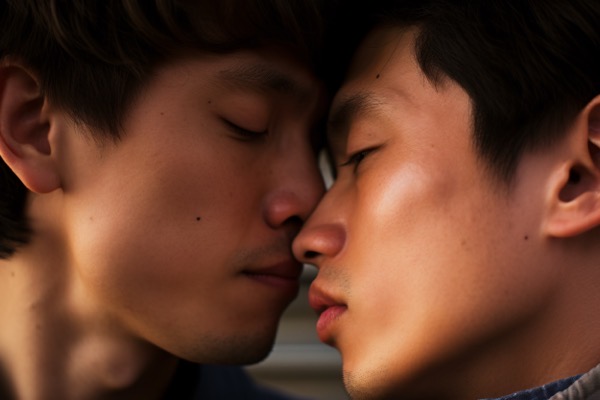
There was a time—not too long ago, really—when queer characters in movies, books, or TV shows lived in the shadows. They weren’t openly queer; instead, we got hints, winks, lingering glances that never landed anywhere concrete. Subtext was the name of the game. And if you caught it, you caught it. If not, well…you probably just assumed they were “very close friends.”
I grew up watching those stories, picking up on the breadcrumbs, and thinking, Okay, that’s as good as it’s going to get. It was like an open secret between queer audiences and creators: we see you, but we can’t say it. And honestly, it stung. It told us our stories weren’t worth naming out loud.
Queer Coding and the “Secret Language” of Subtext
Remember those “best friends” in old sitcoms who seemed to spend all their time together, shared an apartment that somehow had only one bed, and were inexplicably uninterested in dating anyone else? Yeah. That was us. The writers couldn’t say it, so they painted around the edges. Queer audiences became experts at decoding subtle gestures and veiled references. It was survival storytelling—representation wrapped in plausible deniability.
The problem, of course, was that subtext always left room for erasure. Straight audiences could watch and never once think “queer,” while queer audiences had to work overtime to see themselves reflected. It was exhausting.
The Shift: From “Maybe” to “Hell Yes”
Fast forward to now, and things look different. We’ve gone from “don’t ask, don’t tell” characters to protagonists who proudly walk into the frame, fully themselves. Think of Simon in Love, Simon (and later Victor in Love, Victor), Charlie in Heartstopper, or even Theo in V.E. Schwab’s The Invisible Life of Addie LaRue. These are characters who don’t just exist on the margins—they carry the story.
This shift didn’t happen overnight. It’s the result of decades of activism, queer creators pushing through the noise, and audiences demanding better. It’s also thanks to smaller presses, indie filmmakers, and streaming platforms willing to take risks where big studios once balked.
And here’s the thing: having queer protagonists at the center changes everything. It means we no longer have to squint at coded dialogue or hang our hopes on throwaway lines. We get characters who fall in love, make mistakes, save the world, or screw it up spectacularly—and their queerness is not hidden, but part of the joy.
Why This is Important
When I was a teenager, queer characters usually ended up dead, lonely, or punished by the narrative gods. The infamous “bury your gays” trope was everywhere, and happy endings were rare. So when I watch a show like Heartstopper, where queer kids get to blush, hold hands, and navigate first loves without being shamed, I can’t help but feel a little emotional. This is what we needed decades ago. This is what kids today get to have.
Representation isn’t just about seeing someone who looks or loves like you. It’s about expanding what’s possible. It whispers to young queer folks: “Your story matters. You can be the hero. You get a future.” That’s powerful.
But Let’s Not Pretend the Work Is Done
Of course, it’s not all sunshine and rainbows just yet. For every Our Flag Means Death or Red, White & Royal Blue, there are still industries and countries where queer stories are censored, banned, or scrubbed of identity. Even in supposedly progressive spaces, queer protagonists can still be treated as a “risk” or “niche.”
And let’s not forget that representation often skews toward certain kinds of queerness: cis, white, gay men. We need more trans protagonists, more queer characters of color, more disabled queer heroes, more asexual and aromantic representation. Basically, the rainbow still has some shades missing.
From Here On Out
Still, I celebrate how far we’ve come. When I curl up with a queer romance novel or binge-watch a series where two girls kiss in broad daylight without fear, I feel that seismic cultural shift. Subtext has its place—it was survival—but we’ve moved into an era where queer characters don’t just exist. They thrive. They lead. They inspire.
And that’s something worth shouting about.
So here’s to more queer protagonists, more open stories, and more futures where kids don’t have to squint for representation. They’ll see it, front and center, where it belongs.
Want to Read/Watch Some Fantastic Examples?
If you’re looking for stories where queer characters take the spotlight, here are a few favorites:
- 📚 Heartstopper by Alice Oseman – A tender, joyful series about queer teens navigating love, friendship, and identity.
- 📚 Red, White & Royal Blue by Casey McQuiston – A rom-com about the First Son of the U.S. falling for a British prince. Pure delight.
- 📚 Cemetery Boys by Aiden Thomas – A groundbreaking YA novel featuring a trans Latinx protagonist who accidentally summons the wrong ghost.
- 📚 Felix Ever After by Kacen Callender – A heartfelt, affirming story about identity, self-discovery, and love.
- 🎬 Love, Simon (2018) – The teen rom-com that broke ground in mainstream film, later spawning the series Love, Victor.
- 🎬 Our Flag Means Death (2022–23) – A swashbuckling comedy where queer pirates (yes, pirates!) get their happily-ever-afters.
- 🎬 Portrait of a Lady on Fire (2019) – A gorgeously shot historical romance between two women in 18th-century France.
🌈 What about you—do you remember the first openly queer protagonist you encountered in media? How did it change things for you?

Marek and Randy wanted a second chance at love. What they got was a haunted house, an attic full of secrets, and a ghost who changes everything. A Touch of Cedar – grab your copy HERE
